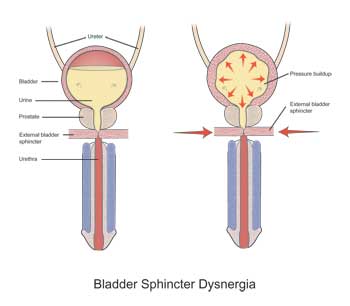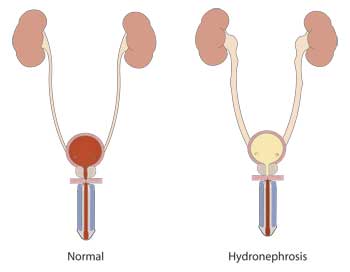
 |

|
Q: What is Bladder Sphincter Dysnergia? A: Bladder Sphincter Dysnergia (BSD) refers to incoordination between the contraction of the bladder and the relaxation of the bladder sphincter.
Q: Does Bladder Sphincter Dysnergia happen with all persons with Spinal Cord Injury? A: No, BSD happens in about half of people with spinal cord injuries.
Q: Will Bladder Sphincter Dysnergia cause other problems for me? A: Since the coordination between bladder contraction and the outlet sphincter are lost, when the bladder contracts and the outlet sphincter doesn�t relax, increased pressure may develop in the bladder. Q: What happens to my bladder when this increased pressure occurs? A: The higher pressure may cause the bladder wall to thicken and outpouchings in the bladder called diverticula to develop.
Q: How will I know if I have bladder sphincter dysnergia? A: Because bladder sphincter dysnergia can develop without symptoms, it is important to follow up regularly with a health care provider who understands this potential complication and knows how to monitor for it. Q: What will my doctor do to find out if I have bladder sphincter dysnergia? A: Screening for this problem may involve x-rays or special scans of the kidneys. These usually need to be done every year or two. Q: What will I have to do if I have bladder sphincter dysnergia? A: If you use an external catheter you may need to switch to an indwelling catheter or intermittent catheter so the bladder is completely emptied and the pressure relieved. Q: What is involved with injections into the sphincter? A: Injections into the sphincter are a new approach that involves the doctor looking through a cystoscope and injecting botulinum toxin (Botox) into the sphincter muscle. This procedure needs to be repeated about every four months to keep the sphincter relaxed. Q: What is involved with cutting the sphincter? A: Cutting the sphincter, an operation called an sphincterotomy, involves cutting the sphincter muscle so that it doesn�t block the flow of urine when the bladder contracts. Q: How is the operation done? A: The operation is done through a cystoscope that is inserted into the urethra that allows the doctor to see the bladder and the sphincter. A surgical knife is then used to cut the sphincter in about three places. Q: Are there side effects with having a sphincterotomy? A: Some men lose their ability to have erections after this procedure and the sphincter cannot be repaired. Q: Will I be able to use any type of bladder technique after a sphincterotomy? A: After a sphincterotomy it is not possible to use the intermittent catheterization or bladder stimulator approach to bladder management. The bladder just doesn�t hold urine very well after a sphincterotomy. |


